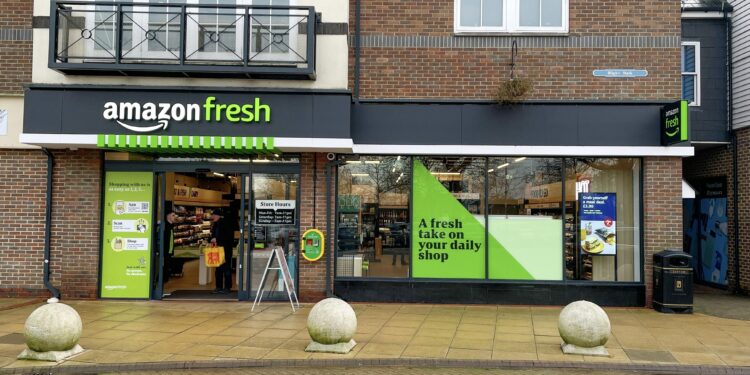Amazon has announced the closure of all its Amazon Fresh grocery stores across the United Kingdom, marking a significant shift in the company’s retail strategy. The decision comes amid growing challenges in the competitive UK grocery market and changing consumer habits. This move will see the shutdown of several physical locations that had aimed to merge technology with everyday shopping. CNN reports on the implications of this development for both customers and the wider grocery sector.
Amazon Fresh Exit Signals Shift in UK Grocery Market Dynamics
The announcement of Amazon Fresh’s exit from the UK market marks a significant turning point in the grocery retail landscape. Despite its global reputation for innovation and convenience, Amazon struggled to carve out a lasting footprint against entrenched competitors and evolving consumer habits. Industry analysts suggest that factors such as high operational costs, fierce competition from well-established supermarket chains, and the complexities of scaling brick-and-mortar grocery stores contributed to this decision. This move not only underscores the challenges tech giants face when entering traditional retail sectors but also highlights a shift in consumer preferences back towards local and personalized shopping experiences.
Key implications of Amazon’s withdrawal include:
- Increased opportunities for domestic and regional grocery chains to expand.
- Greater emphasis on hybrid shopping models combining online ease with in-store immediacy.
- Potential innovation gaps that other players can fill in fresh food delivery and convenience formats.
| Retailer | UK Market Share (%) | Strength |
|---|---|---|
| Tesco | 27.4 | Extensive store network |
| Sainsbury’s | 15.3 | Strong online platform |
| Ocado | 5.7 | Online specialist |
| Amazon Fresh (exiting) | – | Tech integration |
Impact on Consumers and Local Retailers Explored
With Amazon Fresh exiting the UK market, consumers face the disappearance of a unique shopping experience that blended technology, convenience, and competitive pricing. Many customers who relied on Amazon’s seamless integration of online and physical retail will now need to adjust to relying solely on traditional supermarkets or independent grocers. This shift could lead to longer shopping times and potential price increases, especially for those living in areas where Amazon Fresh was one of the few accessible grocery options offering rapid checkout and diverse product ranges.
Local retailers, on the other hand, are likely to experience both challenges and opportunities in the wake of this closure. Smaller grocers might see a temporary boost in foot traffic as displaced Amazon customers seek alternatives, but the sudden influx could strain limited stock and staffing resources. Below is a comparison of expected impacts:
| Aspect | Potential Impact | Notes |
|---|---|---|
| Consumer Prices | Likely Increase | Loss of Amazon’s pricing leverage |
| Shopping Convenience | Decrease | Fewer tech-enhanced options |
| Local Retailers’ Sales | Temporary Boost | Higher footfall but limited inventory |
| Employment | Uncertain | Job losses at Amazon stores vs. new hires by local grocers |
- Consumer habits may shift back to in-store shopping, impacting online grocery adoption trends.
- Local retailers might accelerate digital upgrades to capture customers seeking Amazon’s convenience.
- Community economies will feel the ripple from both lost jobs and increased local commerce.
Strategies for Shoppers Navigating the Amazon Fresh Store Closures
As Amazon Fresh locations shutter across the UK, many shoppers are left reassessing their grocery options. One immediate tactic is to leverage alternative digital platforms with similar delivery and pickup options. Services like Ocado, Waitrose, and Sainsbury’s have ramps up their online availability to absorb displaced customers, offering extensive product ranges and convenient home deliveries. Additionally, consumers should consider diversifying their shopping habits by combining local markets and smaller chain stores to maintain fresh produce variety, often at competitive prices.
To navigate this transition smoothly, keeping a flexible shopping routine is key. Here are some practical strategies to consider:
- Regularly check for promotions across multiple supermarket apps to optimize savings.
- Set up delivery alerts to secure slots early, especially with high demand among competitors.
- Use subscription services for staple goods to avoid stockouts and simplify restocking.
- Explore local co-ops and farmers’ markets for fresh, locally sourced produce supporting community businesses.
| Alternative Store | Delivery Options | Key Benefits |
|---|---|---|
| Ocado | Home Delivery & Click & Collect | Wide product range, frequent deals |
| Waitrose | Home Delivery | High-quality fresh produce |
| Sainsbury’s | Home Delivery & Store Pickup | Broad store network, flexible options |
| Local Farmers’ Markets | In-person shopping | Fresh, seasonal, supports local economy |
Key Takeaways
As Amazon Fresh prepares to close all its UK grocery stores, the move signals a significant shift in the company’s retail strategy amid a challenging market landscape. The closures highlight the difficulties even major players face in the highly competitive grocery sector. As the retail giant refocuses its efforts, the impact on employees, suppliers, and customers will be closely watched in the coming months. This development underscores the evolving dynamics of grocery shopping in the UK and raises questions about the future of physical retail amid growing online alternatives.
















